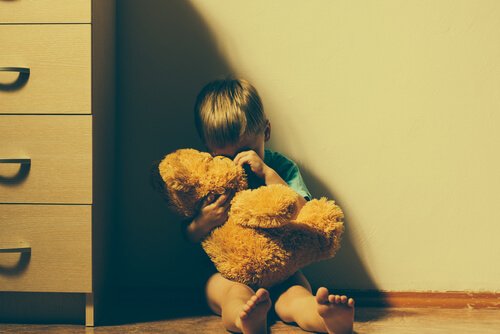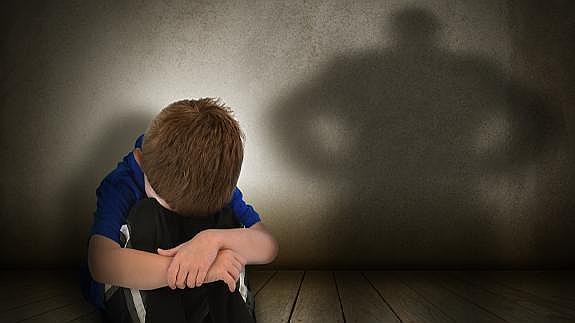How Does Family Violence Affect Children?

The World Health Organization published a study that shows the extent of family violence and other types of abuse in children.
This study shows that a large part of the abuse suffered by children who are 15 years old or younger comes from their families or guardians.
Most of the consequences are visible in the short term. However, the extent of the impact that the violence has is really evident in the long term. After all, children’s health is affected on many levels: physical, psychological and emotional.
What is family violence?
We teach children to value the family unit from a young age. However, family violence can greatly harm this idea. Each day, there is an increase in the number of people with emotional wounds who reject their family.
Family violence is defined as all demonstrations of mistreatment and abuse in the nuclear family. It often happens frequently and varies in its intensity.
There are many causes of family violence. However, it involves a certain profile (of the aggressor) that includes many aspects – these can be low self-esteem, poor management of emotions and feelings, intolerance and the use of violence as a tool for power.

Evolution of family violence
- Stage 1 (Tension). In this stage, the aggressors create tension in order to place themselves above their victims (the children). This stage is marked by verbal and psychological abuse.
- Stage 2 (Physical aggression). In this phase the abusers lose control of their emotions for any random reason. They unleash all of their frustrations and negativity on their victims. The episodes of violence can include (or not) physical aggression independent of this. This leaves the victim scared and confused.
- Stage 3 (Remorse). In this stage, the aggressors try to offer apologies and show remorse for the damages they have caused. Nevertheless, they don’t really fix their behavior.
These stages can repeat over time, deepening the toxic relationship and vicious cycle of violence.
Consequences of family violence in children
The most common consequence of family violence in children is that they adopt the violent behavior as a defense mechanism.
- Physical consequences such as: insomnia, stomach problems, headaches, self-harm, loss of sphincter control, etc.
- In the emotional aspect: low self-esteem, feelings of guilt, erratic behavior, depression, anxiety, isolation, irritability.
- On the other hand, in an academic aspect, children can have a poor performance in school, bad interactions and toxic relationships.
Remember that the best option will always be to choose healthy alternatives that can benefit everyone.
How to stop or prevent abuse
Helping stop and prevent family violence is a social commitment. The first step in stopping family abuse is to recognize the problem.

After that, seek help from a public service. Later, do the following:
- Help your children develop a healthy self-esteem. This will make them appreciate themselves and look for help against any kind of abuse.
- Be the example. Learn to calm down and that attitude will be reflected in them.
- Help them set realistic goals so they will learn how to adjust their perspectives.
- Seek the help of the school counselor or a psychologist. Getting over child abuse can be hard. Be constant and offer them lots of love and understanding.
- Guide them to look at the positive part of the experiences and learning.
- Set reasonable limits and help them comply without the need for violence and insults.
Only a healthy environment can offer healthy day-to-day development for children.
Everyone at home should focus on looking for healthy solutions that benefit everyone. Most of all, it’s important to educate in respect and avoid violence. There are solutions which are much better and more effective.
All cited sources were thoroughly reviewed by our team to ensure their quality, reliability, currency, and validity. The bibliography of this article was considered reliable and of academic or scientific accuracy.
- Almenares Aleaga, M., Louro Bernal, I., & Ortiz Gómez, M. T. (1999). Comportamiento de la violencia intrafamiliar. Revista cubana de Medicina general Integral, 15, 285-292. http://scielo.sld.cu/scielo.php?script=sci_arttext&pid=S0864-21251999000300011
- Amar Amar, J. J., Kotliarenko, M. A., & Abello Llanos, R. (2010). Factores psicosociales asociados con la resiliencia en niños colombianos víctimas de violencia intrafamiliar. Investigación & desarrollo, 11(1). http://rcientificas.uninorte.edu.co/index.php/investigacion/article/viewFile/1134/710
- Amar Amar, J., & Berdugo de Gómez, M. (2011). Vínculos de apego en niños víctimas de la violencia intrafamiliar. Psicología desde el Caribe, 1-22. http://rcientificas.uninorte.edu.co/index.php/psicologia/article/view/2076
- González Álvarez, M. (2012). Violencia intrafamiliar: características descriptivas, factores de riesgo y propuesta de un plan de intervención. https://eprints.ucm.es/id/eprint/16421/1/T33906.pdf
- Medina, J. C. (2010). Violencia intrafamiliar. Derecho y Realidad, 8(16). https://revistas.uptc.edu.co/index.php/derecho_realidad/article/download/4946/4014
- Muñiz Ferrer, M. C., Jiménez García, Y., Ferrer Marrero, D., González Pérez, J., & Rondón García, I. (1996). Sobre la percepción de la violencia intrafamiliar por los niños. Revista Cubana de Medicina General Integral, 12(2), 126-131. http://scielo.sld.cu/scielo.php?pid=S0864-21251996000200003&script=sci_arttext&tlng=pt
This text is provided for informational purposes only and does not replace consultation with a professional. If in doubt, consult your specialist.








